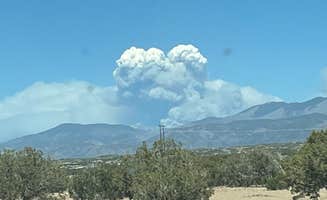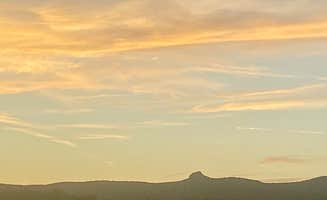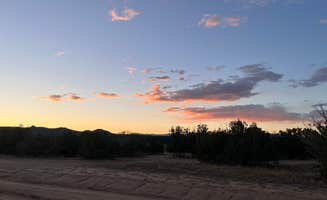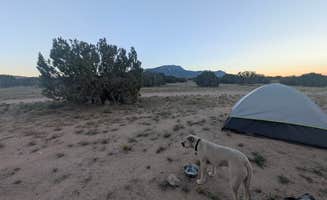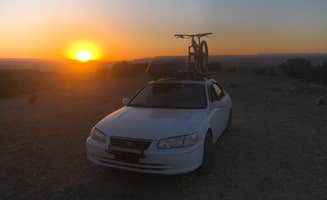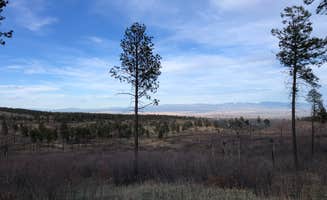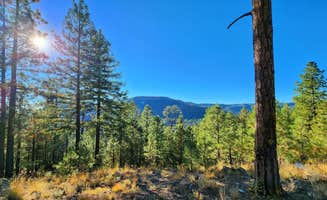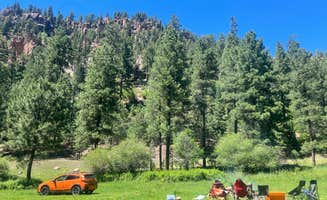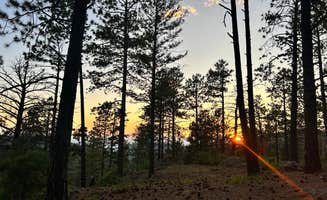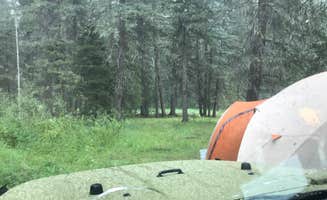Dispersed camping near Peña Blanca offers primitive sites throughout Santa Fe National Forest and surrounding public lands at elevations ranging from 5,500 to 8,800 feet. The high desert climate brings dramatic temperature swings, with summer days reaching 90°F and winter nights dropping below freezing. Most dispersed camping areas require visitors to be entirely self-sufficient, with no established facilities beyond occasional vault toilets at major access points.
What to do
Hiking near Valles Caldera: Forest Service Road 268 dispersed camping areas provide direct access to numerous hiking trails that wind through volcanic landscapes. One camper noted, "There was no smell, but I could hear all of the equipment in the morning" at a site near Los Alamos, showing how even remote sites can have subtle industrial sounds.
Explore water features: Dispersed on 4 near Fenton Lake State Park offers access to both hot springs and riverside trails. "I also went on a hike at Los Conchas Trail maybe 10 minutes up the road (away from Jemez Springs) and was shocked by the beauty!! What a wonderful hike!" writes one camper who stayed in the area.
Wildlife viewing opportunities: The American Springs area provides excellent wildlife watching. "Elk grazing below were the cherry on top," reports a visitor to this quieter camping zone, highlighting the natural encounters possible when camping in the less developed areas around Peña Blanca.
What campers like
High elevation escapes from summer heat: Forest Service Rd 268 Dispersed Site offers cooler temperatures due to its 8,800-foot elevation. "Great place to get away for the week. Cattle will walk thru your camp and people were far enough away to enjoy the cool," notes one camper who used the site to escape summer heat.
Extensive flat camping areas: Many primitive camping sites feature level terrain suitable for various camping setups. "We found it to be clean, open flat ground to camp on. Spent a couple of days. Beautiful spot," shares a visitor to the BLM Road 62 area, highlighting the practical advantage of finding ready-to-use campsites.
Winter accessibility: Some dispersed sites remain accessible even during colder months. "I arrived after dark on December 28th... It was completely deserted, except for one RV. In the morning I discovered a car which looks like someone may be living in the park, but saw no signs of anyone," reports a winter camper at BLM Road 62, noting the solitude of off-season camping.
What you should know
Road conditions vary seasonally: American Springs requires appropriate vehicles for access. "Probably not a must have, but I highly recommend a four-wheel-drive high clearance to get back into the camp spots here, but there are a handful of spots," advises a camper who visited this rustic camping spot near Peña Blanca.
Target flat, established sites: Look for previously used spots to minimize environmental impact. "We opted not to camp in the 'lot' where a lot of people set up. We drove back the road a bit further for some privacy. The area is very dusty," explains a visitor to the Santa Fe BLM area.
Cell service is inconsistent: Coverage varies significantly across the region. "Cell service is spotty," notes a camper at BLM Road 62, contrary to some reports of good service. This highlights the importance of not relying on connectivity when visiting primitive camping areas near Peña Blanca.
Tips for camping with families
Safety considerations: Water Canyon provides secluded camping but requires preparation. "Plenty of space for the truck and several tents. Nice fire pit. Overview of the canyon. Trailers probably can't get here. Four-wheel-drive recommended," advises a camper, emphasizing the need for appropriate vehicles when bringing children to remote sites.
Pack for temperature fluctuations: The high desert environment brings cold nights even in summer. "It's going to get colder than you think at night. Bring a fleece or warm jacket at the least," warns a visitor to Dispersed on 4, highlighting the temperature drops that can catch unprepared families off guard.
Avoid high winds with children: Some exposed sites experience significant wind. "The main downside to this was how windy it was so I did not enjoy campfires until the third night and it was no longer windy," reports a camper, suggesting that families should seek protected sites among juniper trees rather than exposed ridgelines.
Tips from RVers
Best RV-accessible areas: Top of New Mexico - Dispersed Site accommodates larger vehicles despite some access challenges. "Mostly residential area until you get to the open space. I didn't make it to the actual coordinates as I took a wrong turn near the end, but there is a ton of open space out here. Easy to get to in 25' RV. Recommend," shares an RV camper who found suitable sites.
Prepare for dust in RVs: The fine desert dust infiltrates vehicles and RVs. "A gorgeous and vast dispersed campground just a short drive from Santa Fe. The only downside: it was very windy and the entire interior of my vehicle was covered in reddish dust," reports a camper at Caja Del Rio, noting a common challenge when primitive camping near Peña Blanca with RVs.
Site selection for larger rigs: Look for open areas that don't require tight maneuvering. "The gravel roads are really tight for my 27" trailer, manageable but did rub on a couple of trees and shrubs on the drive in," explains a camper at Top of New Mexico, highlighting access considerations for larger vehicles.


